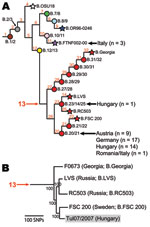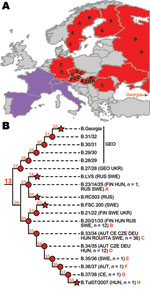Volume 18, Number 2—February 2012
Dispatch
Phylogeography of Francisella tularensis subsp. holarctica, Europe
Abstract
Francisella tularensis subsp. holarctica isolates from Austria, Germany, Hungary, Italy, and Romania were placed into an existing phylogeographic framework. Isolates from Italy were assigned to phylogenetic group B.FTNF002–00; the other isolates, to group B.13. Most F. tularensis subsp. holarctica isolates from Europe belong to these 2 geographically segregated groups.
Francisella tularensis is the etiologic agent of tularemia and a highly virulent category A biothreat agent (1,2). The most widely distributed subspecies is F. tularensis subsp. holarctica, which is found throughout much of the Northern Hemisphere and is the only subspecies found in Europe (3). Despite its wide geographic distribution, F. tularensis subsp. holarctica contains low genetic diversity, which indicates recent emergence (4). A recent global phylogeographic analysis (5), and several subsequent analyses (6–9), assigned most isolates from Europe to 2 phylogenetic groups: B.FTNF002–00 and B.13 (includes multiple subclades descended from branch B.13 [5,6,8]; branch and subclade nomenclature from [5] has been shortened by removing Br and extra 0s from individual branch and subclade names). These groups appear to be geographically segregated: only isolates from B.FTNF002–00 have been reported from the western European countries of Spain, France, and Switzerland, whereas B.13 is the only or dominant type reported from the Czech Republic, Finland, Georgia, Russia, Slovakia, and Ukraine (5–9). We provide additional information about the geographic distribution of these 2 groups using existing phylogenetic signatures (5,8) to place 45 isolates from Austria, Germany, Hungary, Italy, and Romania (Table A1) into the existing global phylogeographic framework.
All of the isolates were assigned to group B.FTNF002–00 or to group B.13. All 3 isolates from Italy were assigned to group B.FTNF002–00 (Figure 1, panel A). Although the sample size was small, these isolates were obtained in 3 different years (Table A1), which suggests that this group is ecologically established in Italy. These results increase the known geographic distribution of this group, which appears to be the dominant clone in western Europe (Figure 2, panel A, purple shading). All 42 isolates from Austria, Germany, Hungary, and Romania were assigned to group B.13 (Figure 1, panel A), further demonstrating that B.13 is the most prevalent group of F. tularensis subsp. holarctica in central and eastern Europe (Figure 2, panel A, red shading). Within group B.13, one isolate from Hungary was assigned to subclade B.23/14/25 (Figure 1, panel A); isolates from Finland, Russia, and Sweden were previously assigned to this subclade (6,8) (Figure 2, panel B). However, the other 41 isolates were assigned to subclade B.20/21 (Figure 1, panel A).
We identified new genomic signatures to provide increased genetic resolution within subclade B.20/21. Next-generation sequencing technology (Illumina Inc., San Diego, CA, USA) was used to sequence the genome of an isolate from Hungary (Tul07/2007, GenBank accession no. SRX025133) assigned to subclade B.20/21. Putative single nucleotide polymorphisms (SNPs) were identified in the resulting sequence and the genomes of 4 other strains previously assigned to group B.13 (LVS, AM233362.1; FSC 200, AASP00000000; RC503, SRX000104; Georgia F0673, SRX025885) by using an existing bioinformatics pipeline (5). The more distantly related strain OSU18 (CP000437.1) genome was also included as an outgroup. A maximum-parsimony tree was constructed by using the resulting ≈700 putative SNPs and PAUP 4.0b10 software (Sinauer Associates, Inc., Sunderland, MA, USA) (Figure 1, panel B). Most of the putative SNPs separated OSU18 from the B.13 strains (data not shown), but the remaining putative SNPs provided resolution among the B.13 strains, including 20 putative SNPs specific to the branch leading to the strain from Hungary (Figure 1, panel B). Consistent with previous analyses (Figure 1, panel A), the strain from Hungary clustered as a sister taxon to strain FSC 200 (Figure 1, panel B).
To show additional phylogenetic structure within subclade B.20/21, we designed genotyping assays targeting the 20 putative SNPs along the branch leading to the strain from Hungary (Figure 1, panel B) and screened them across 64 isolates assigned to subclade B.20/21. This analysis included the 41 isolates from Austria, Germany, Hungary, and Romania, as well as 23 additional isolates from central Europe, the Czech Republic, Finland, Russia, and Sweden that were previously assigned to this subclade (6,8) (Table A1). The assays were constructed and performed as described (5) by using an annealing temperature of 60°C. All 20 SNPs were laboratory confirmed, and 52 of the isolates were assigned to 6 new subclades (B.33/34, B.34/35, B.35/36, B.36/37, B.37/38, and B.Tul07/2007); the 12 other isolates remained in the basal subclade, now identified as B.20/21/33 (Figure 2, panel B; Table A1). Information about assays targeting canonical SNPs for the branches leading to the 6 new subclades are presented in the Table.
Our results are consistent with complex dispersal patterns within the B.13 group of F. tularensis subsp. holarctica. Several of the B.13 subclades identified in this study are broadly distributed throughout central and eastern Europe (Figure 2, panel A), including subclades B.20/21/33, B.33/34, and B.34/35. All of the new subclades containing >1 isolate have representatives from multiple countries (Figure 2, panel B). Other previously identified B.13 subclades, including B.27/28, B.LVS, B.23/14/25, and B.21/22 are also broadly distributed (Figure 2, panel A).
This study and previous studies have increased understanding of F. tularensis subsp. holarctica in Europe by placing isolates from multiple countries into the existing global phylogeographic framework. As a result, the genetic background is becoming defined for each country (i.e., the specific subtypes reported from each country). This information can be useful for identifying intentional (e.g., bioterrorism) or unintentional movement of F. tularensis subsp. holarctica between countries. For example, the isolate from Romania examined in this study was actually isolated in Italy from an infected hare that was shipped from Romania for hunting. Genotyping results are consistent with a Romanian origin for this isolate because it was assigned to the B.13 group that is widespread in central and eastern Europe (Figure 2, panel A) and not to the B.FTNF002–00 group, to which the isolates from Italy were assigned (Figure 1, panel A).
Understanding global phylogeographic patterns is possible only if isolates from multiple geographic locations are placed within the same framework (i.e., examined with the same genomic signatures). Because F. tularensis is genetically monomorphic and highly clonal, SNPs are preferred signatures for determining phylogenetic structure within this species (3). Vogler et al. (5) conducted the first SNP-based global phylogeographic analysis of F. tularensis. Subsequent studies (6–8) have used the SNP signatures described by Vogler et al. (5) and new SNPs discovered from new whole-genome sequences or multiple sequence typing data to further refine phylogeographic patterns within F. tularensis, particularly F. tularensis subsp. holarctica. These new signatures, when screened across diverse isolate collections, have identified new subclades within preexisting subclades. This pattern will continue as whole-genome sequencing becomes less expensive and more widely available. As a result, the nomenclature of phylogenetic groups within F. tularensis and the particular subclade to which a given isolate is assigned are constantly changing and will continue to change, which makes comparison of results and findings across different studies difficult. To address this problem, we have included all known F. tularensis subsp. holarctica SNP-based phylogenetic groups within our phylogenetic trees (Figure 1, panel A; Figure 2, panel B), including those discovered by other researchers. In addition, for the isolates analyzed in this study (Table A1), where applicable, we have listed the phylogenetic groups to which they were assigned in previous studies.
Dr Gyuranecz is a postdoctoral fellow at the Veterinary Medical Research Institute, Hungarian Academy of Sciences, Budapest, Hungary. His primary research interest is zoonotic wildlife diseases.
Acknowledgments
We thank Talima Pearson for helpful discussions and Megan Shuey for technical assistance with whole-genome sequencing.
This work was supported in part by the US Department of Homeland Security Science and Technology Directorate through awards HSHQDC-10-C-00139 and 2010-ST-108-000015.
References
- Dennis DT, Inglesby TV, Henderson DA, Bartlett JG, Ascher MS, Eitzen E, Tularemia as a biological weapon: medical and public health management. JAMA. 2001;285:2763–73. DOIPubMedGoogle Scholar
- Rotz LD, Khan AS, Lillibridge SR, Ostroff SM, Hughes JM. Public health assessment of potential biological terrorism agents. Emerg Infect Dis. 2002;8:225–30. DOIPubMedGoogle Scholar
- Keim P, Johansson A, Wagner DM. Molecular epidemiology, evolution, and ecology of Francisella. Ann N Y Acad Sci. 2007;1105:30–66. DOIPubMedGoogle Scholar
- Keim PS, Wagner DM. Humans and evolutionary and ecological forces shaped the phylogeography of recently emerged diseases. Nat Rev Microbiol. 2009;7:813–21. DOIPubMedGoogle Scholar
- Vogler AJ, Birdsell D, Price LB, Bowers JR, Beckstrom-Sternberg SM, Auerbach RK, Phylogeography of Francisella tularensis: global expansion of a highly fit clone. J Bacteriol. 2009;191:2474–84. DOIPubMedGoogle Scholar
- Chanturia G, Birdsell DN, Kekelidze M, Zhgenti E, Babuadze G, Tsertsvadze N, Phylogeography of Francisella tularensis subspecies holarctica from the country of Georgia. BMC Microbiol. 2011;11:139. DOIPubMedGoogle Scholar
- Pilo P, Johansson A, Frey J. Identification of Francisella tularensis cluster in central and western Europe. Emerg Infect Dis. 2009;15:2049–51. DOIPubMedGoogle Scholar
- Svensson K, Granberg M, Karlsson L, Neubauerova V, Forsman M, Johansson A. A real-time PCR array for hierarchical identification of Francisella isolates. PLoS ONE. 2009;4:e8360. DOIPubMedGoogle Scholar
- Vogler AJ, Birdsell DN, Lee J, Vaissaire J, Doujet CL, Lapalus M, Phylogeography of Francisella tularensis ssp. holarctica in France. Lett Appl Microbiol. 2011;52:177–80. DOIPubMedGoogle Scholar
Figures
Tables
Cite This Article1These authors contributed equally to this article.
Table of Contents – Volume 18, Number 2—February 2012
| EID Search Options |
|---|
|
|
|
|
|
|


Please use the form below to submit correspondence to the authors or contact them at the following address:
David M. Wagner, PO Box 4073, Center for Microbial Genetics and Genomics, Northern Arizona University, Flagstaff AZ, 86011-4073, USA
Top